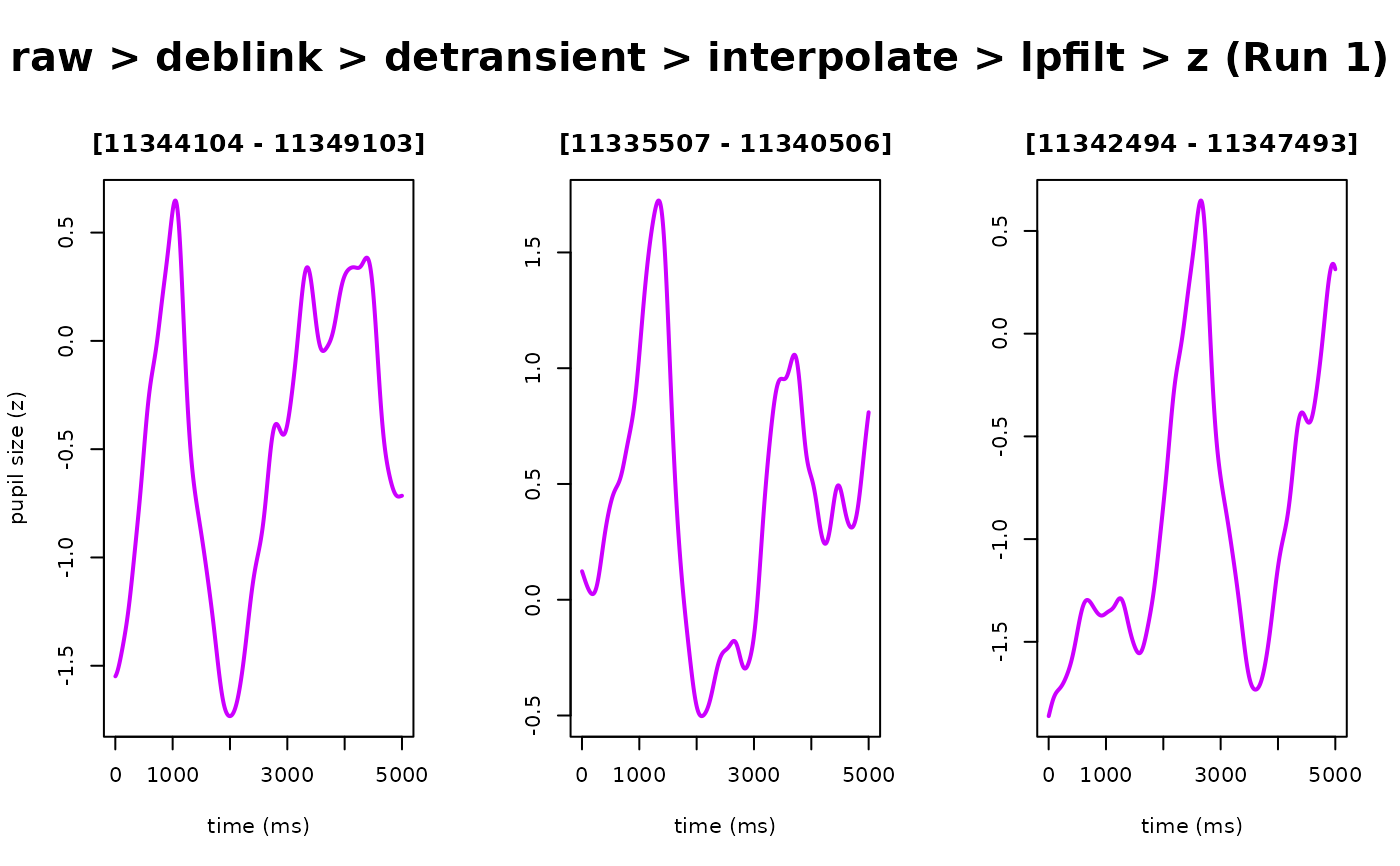
Remove pupil samples that are physiologically unlikely
Source:R/pipeline-detransient.R
detransient.RdThe intended use of this method is for removing pupil samples that emerge
more quickly than would be physiologically expected. This is accomplished by
rejecting samples that exceed a "speed"-based threshold (i.e., median
absolute deviation from sample-to-sample). This threshold is computed based
on the constant n, which defaults to the value 16.
Arguments
- eyeris
An object of class
eyerisderived fromload_asc()- n
A constant used to compute the median absolute deviation (MAD) threshold. Defaults to
16- mad_thresh
Default
NULL. This parameter provides alternative options for handling edge cases where the computed properties here withindetransient()\(mad\_val\) and \(median\_speed\) are very small. For example, if $$mad\_val = 0 \quad \text{and} \quad median\_speed = 1,$$ then, with the default multiplier \(n = 16\), $$mad\_thresh = median\_speed + (n \times mad\_val) = 1 + (16 \times 0) = 1.$$ In this situation, any speed \(p_i \ge 1\) would be flagged as a transient, which might be overly sensitive. To reduce this sensitivity, two possible adjustments are available:If \(mad\_thresh = 1\), the transient detection criterion is modified from $$p_i \ge mad\_thresh$$ to $$p_i > mad\_thresh .$$
If \(mad\_thresh\) is very small, the user may manually adjust the sensitivity by supplying an alternative threshold value here directly via this
mad_threshparameter.
- call_info
A list of call information and parameters. If not provided, it will be generated from the function call. Defaults to
NULL
Details
This function is automatically called by glassbox() by default. If needed,
customize the parameters for detransient by providing a parameter list. Use
glassbox(detransient = FALSE) to disable this step as needed.
Users should prefer using glassbox() rather than invoking this function
directly unless they have a specific reason to customize the pipeline
manually.
Computed properties:
pupil_speed: Compute speed of pupil by approximating the derivative ofx(pupil) with respect toy(time) using finite differences.Let \(x = (x_1, x_2, \dots, x_n)\) and \(y = (y_1, y_2, \dots, y_n)\) be two numeric vectors with \(n \ge 2\); then, the finite differences are computed as: $$\delta_i = \frac{x_{i+1} - x_i}{y_{i+1} - y_i}, \quad i = 1, 2, \dots, n-1.$$
This produces an output vector \(p = (p_1, p_2, \dots, p_n)\) defined by:
For the first element: $$p_1 = |\delta_1|,$$
For the last element: $$p_n = |\delta_{n-1}|,$$
For the intermediate elements (\(i = 2, 3, \dots, n-1\)): $$p_i = \max\{|\delta_{i-1}|,\,|\delta_i|\}.$$
median_speed: The median of the computedpupil_speed: $$median\_speed = median(p)$$mad_val: The median absolute deviation (MAD) ofpupil_speedfrom the median: $$mad\_val = median(|p - median\_speed|)$$mad_thresh: A threshold computed from the median speed and the MAD, using a constant multiplier \(n\) (default value: 16): $$mad\_thresh = median\_speed + (n \times mad\_val)$$
Note
This function is part of the glassbox() preprocessing pipeline and is not
intended for direct use in most cases. Provide parameters via
detransient = list(...).
Advanced users may call it directly if needed.
See also
glassbox() for the recommended way to run this step as
part of the full eyeris glassbox preprocessing pipeline.
Examples
demo_data <- eyelink_asc_demo_dataset()
demo_data |>
eyeris::glassbox(
detransient = list(n = 16) # set to FALSE to skip step (not recommended)
) |>
plot(seed = 0)
#> ✔ [ OK ] - Running eyeris::load_asc()
#> ℹ [ INFO ] - Processing block: block_1
#> ✔ [ OK ] - Running eyeris::deblink() for block_1
#> ✔ [ OK ] - Running eyeris::detransient() for block_1
#> ✔ [ OK ] - Running eyeris::interpolate() for block_1
#> ✔ [ OK ] - Running eyeris::lpfilt() for block_1
 #> ! [ SKIP ] - Skipping eyeris::downsample() for block_1
#> ! [ SKIP ] - Skipping eyeris::bin() for block_1
#> ! [ SKIP ] - Skipping eyeris::detrend() for block_1
#> ✔ [ OK ] - Running eyeris::zscore() for block_1
#>
#> Block processing summary:
#> block_1: OK (steps: 6, latest: pupil_raw_deblink_detransient_interpolate_lpfilt_z)
#>
#> ✔ [ OK ] - Running eyeris::summarize_confounds()
#> ! [ INFO ] - Plotting block 1 from possible blocks: 1
#> ℹ [ INFO ] - Plotting with sampling rate: 1000 Hz
#> ! [ SKIP ] - Skipping eyeris::downsample() for block_1
#> ! [ SKIP ] - Skipping eyeris::bin() for block_1
#> ! [ SKIP ] - Skipping eyeris::detrend() for block_1
#> ✔ [ OK ] - Running eyeris::zscore() for block_1
#>
#> Block processing summary:
#> block_1: OK (steps: 6, latest: pupil_raw_deblink_detransient_interpolate_lpfilt_z)
#>
#> ✔ [ OK ] - Running eyeris::summarize_confounds()
#> ! [ INFO ] - Plotting block 1 from possible blocks: 1
#> ℹ [ INFO ] - Plotting with sampling rate: 1000 Hz





